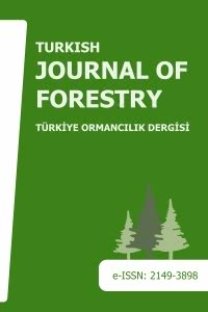Calculation of average skidding distance on sloping terrain with GIS tools
eğimli arazi, yüzey alanı, sürütme, coğrafi bilgi sistemleri, Isparta
CBS araçları ile eğimli arazilerde ortalama sürütme mesafesinin hesaplanması
sloping land, surface area, skidding, geographical information systems, Isparta,
___
- Balcı, İ., Çoban, H. O., Eker, M., 2000. Geographic Information System. Süleyman Demirel University, Faculty of Forestry Journal, A (1), 115-132.
- Bayoğlu, S., 1972. A study on forest transportation and development possibilities. Istanbul University, Faculty of Forestry, 1747/185, 73p.
- Contreras, M. and Chung, W., 2007. Computer approach to finding an optimal log landing location and analyzing influencing factors for ground-based timber harvesting. Canadian Journal of Forest Research, 37(2), 276-292.
- Clark, M.M., 1998. The forest harvesting problem: integrating operational and tactical planning. Auburn University, Industrial and System Engineering (PhD dissertation), USA, 296 p.
- CRWR, 2011. ArcHydro: GIS for water resources, center for research in water resources. University of Texas at Austin, http://www.crwr.utexas.edu/giswr/hydro/, (Last visit:16 April 2011), USA.
- Çoban, H.O., 2004. Production of thematic forest maps supported by computer system. Süleyman Demirel University, Faculty of Forestry Journal, A (2), 83-96.
- Donnelly D.M., 1978. Computing average skidding distance for logging areas with irregular boundaries and variable log density. GTR-RM-58, Rocky Mountain Forest and Range Experiment Station Forest Service, USDA, 10 p.
- Eker, M., 2004. Development of annual operational planning model for timber harvesting. Karadeniz Technical University (PhD dissertation), Trabzon, 239 p.
- Eker, M., Çoban, H.O., 2010. Impact of road network on the structure of a multifunctional forest landscape unit in southern Turkey. Journal of Environmental Biology, 31:157-168.
- Eker, M., 2011. Assessment of procurement systems for unutilized logging residues for Brutian pine forest of Turkey. African Journal of Biotechnology, 10(13):2455-2468.
- Erdaş, O., 1997. Forest roads –Vol.1. Karadeniz Technical University, Faculty of Forestry, Trabzon, 187/25, 390 p.
- ESRI, 2011. ArcGIS Desktop software characteristics. Environmental Systems Research Institute, www.esri.com (Last visit: 15 July 2011).
- Garner, G.J., 1979. Cut-block area and average primary transport distance. Internal Report of the Forest Engineering Research Institute of Canada, Pointe Claire, Quebec, 10 p.
- Greulich, F.E., 1987. The quantitative description of cable yarder settings - parameters for the triangular setting with apical landing. For. Sci. 33(3):603-616.
- Greulich, F.E., 1995. Road network design: optimal economic connection of three horizontal control points on flat, uniform terrain. J. For. Eng. 7(1):73-82.
- Greulich, F.E., 1997. An algorithm for optimal centralized landing location: rectilinear yarding operations on flat uniform terrain. Canadian Journal of Forest Research, 27(8):1192-1197.
- Kluender, R., Weih, R., Corrigan, M., and Pickett, J., 2000. The use of a geographic information system in harvest landing location for ground-based skidding operations. Forest products journal, 50(3):87-92.
- Liu, S. and Corcoran, T.J., 1993. Road and landing spacing under the consideration of surface dimension of road and landings. Journal of Forest Engineering, 5(1):49-53.
- Lussier, L.J., 1961. Planning and control of logging operations. Forest Research Foundation, Laval Universty, Quebec,135 p.
- Mathews, D. M., 1942. Cost control in the logging industry. McGraw-Hill. Peters, P.A., 1978. Spacing of roads and landings to minimize timber harvest cost. Forest Science, 24 (2), 209-217.
- Sessions, J. and Guangda. L., 1987. Deriving optimal road and landing spacing with microcomputer programs. Western J of Applied Forestry, 2 (3), 94-98.
- Suddarth, SK. and Herrick. A.M., 1964. Average skidding distance for theoretical analysis of logging costs. Research Bulletion, 789 Purdue University Experiment Station.
- Sundberg, U. and Silversides, C.R., 1988. Operational efficinecy in forestry. Kluwer Academic Publishers, 216 p.
- Thompson, M.A., 1992. Considering overhead costs in road and landing spacing models. Journal of Forest Engineering, 3(2), 13–19.
- Tucek, J. ve Pacola, E., 1999. Algorithms for skidding distance modeling on a raster digital terrain model. Journal of Forest Engineering, 10(1), 67-79.
- Tucek, J. and Pacola, R., 2005. Spatial decision support system for laying out forest roads on the basis of skidding distances modeling. Special Issue of the Journal Nova Meh. Sumar., 26(2), 97-102.
- Twito, R.H. and Mann, C.N., 1979. Determining average yarding distance. GTR-PNW-79, Pacific Northwest Forest and Range Experiment Station Forest Service, USDA, 29 p.
- ISSN: 1302-7085
- Yayın Aralığı: Yılda 2 Sayı
- Başlangıç: 2000
Kutu mobilyalarda L-köşe bileşim elemanının yük taşıma kapasitesine etkisi
Bahçe sanatı tarihinde ünlü bir sanatkar: Gertrude Jekyll
NİLÜFER YAZICI, Süleyman ÖZHAN, A. Alper BABALIK
Mersin (C12), Trabzon ve Gümüşhane (A4)’ den bazı karayosunu (musci) kayıtları
SERDAR SELİM, Nihat KARAKUŞ, Selma ELKAN, CEREN SELİM
Mezun peyzaj mimarlarının eğitim ve öğretimden beklentileri
ATİLA GÜL, Ömer K. ÖRÜCÜ, Şehriban ERASLAN
AYTEN EROL GÖRÜR, Şeyhmus İLHAN
Orman yolu kalite analizine yönelik ölçüt ve gösterge setinin oluşturulması
Orman genetiği ve biyoteknolojisi
